Efficient Color Correction Using Normalized Singular Value for Duststorm Image Enhancement
Abstract
:1. Introduction
2. Background
3. Proposed Method
3.1. Efficient Color Correction
3.2. Estimate Adjustable Dark Channel Prior
3.3. Image Enhancement
4. Experimental Results and Discussion
4.1. Subjective Comparison
4.2. Objective Comparison
5. Conclusions
Funding
Conflicts of Interest
References
- He, K.; Sun, J.; Tang, X. Single image haze removal using dark channel prior. IEEE Trans. Pattern Anal. Mach. Intell. 2010, 33, 2341–2353. [Google Scholar]
- Meng, G.; Wang, Y.; Duan, J.; Xiang, S.; Pan, C. Efficient image dehazing with boundary constraint and contextual regularization. In Proceedings of the IEEE International Conference on Computer Vision, Sydney, Australia, 1–8 December 2013. [Google Scholar]
- Zhu, Q.; Mai, J.; Shao, L. A fast single image haze removal algorithm using color attenuation prior. IEEE Trans. Image Process. 2015, 24, 3522–3533. [Google Scholar]
- Al-Ameen, Z. Visibility enhancement for images captured in dusty weather via tuned tri-threshold fuzzy intensification operators. Int. J. Intell. Syst. Appl. 2016, 8, 10. [Google Scholar] [CrossRef] [Green Version]
- Naseeba, T.; Harish Binu, K.P. Visibility Restoration of Single Hazy Images Captured in Real-World Weather Conditions. 2016.
- Kwok, N.; Wang, D.; Jia, X.; Chen, S.; Fang, G.; Ha, Q. Gray world based color correction and intensity preservation for image enhancement. In Proceedings of the 2011 4th International Congress on Image and Signal Processing, Shanghai, China, 15–17 October 2011; Volume 2. [Google Scholar]
- Gao, G.; Lai, H.; Jia, Z.; Liu, Y.Q.; Wang, Y. Sand-dust image restoration based on reversing the blue channel prior. IEEE Photonics J. 2020, 12, 1–16. [Google Scholar] [CrossRef]
- Shi, Z.; Feng, Y.; Zhao, M.; Zhang, E.; He, L. Let you see in duststorm weather: A method based on halo-reduced dark channel prior dehazing for sand-dust image enhancement. IEEE Access 2019, 7, 116722–116733. [Google Scholar] [CrossRef]
- Huo, J.-Y.; Chang, Y.-L.; Wang, J.; Wei, X.-X. Robust automatic white balance algorithm using gray color points in images. IEEE Trans. Consum. Electron. 2006, 52, 541–546. [Google Scholar]
- He, K.; Sun, J.; Tang, X. Guided image filtering. IEEE Trans. Pattern Anal. Mach. Intell. 2012, 35, 1397–1409. [Google Scholar] [CrossRef]
- Cheng, Y.; Jia, Z.; Lai, H.; Yang, J.; Kasabov, N.K. A fast sand-dust image enhancement algorithm by blue channel compensation and guided image filtering. IEEE Access 2020, 8, 196690–196699. [Google Scholar] [CrossRef]
- Shi, Z.; Feng, Y.; Zhao, M.; Zhang, E.; He, L. Normalised gamma transformation-based contrast-limited adaptive histogram equalisation with colour correction for sand–dust image enhancement. IET Image Process. 2019, 14, 747–756. [Google Scholar] [CrossRef]
- Wang, A.; Wang, W.; Liu, J.; Gu, N. AIPNet: Image-to-image single image dehazing with atmospheric illumination prior. IEEE Trans. Image Process. 2018, 28, 381–393. [Google Scholar] [CrossRef]
- Zhang, J.; Tao, D. FAMED-Net: A fast and accurate multi-scale end-to-end dehazing network. IEEE Trans. Image Process. 2019, 29, 72–84. [Google Scholar] [CrossRef] [PubMed] [Green Version]
- Ren, W.; Liu, S.; Zhang, H.; Pan, J.; Cao, X.; Yang, M.-H. Single image dehazing via multi-scale convolutional neural networks. In European Conference on Computer Vision; Springer: Cham, Switzerland, 2016. [Google Scholar]
- Fattal, R. Single image dehazing. ACM Trans. Graph. (TOG) 2008, 27, 1–9. [Google Scholar] [CrossRef]
- Narasimhan, S.G.; Nayar, S.K. Chromatic framework for vision in bad weather. In Proceedings of the IEEE Conference on Computer Vision and Pattern Recognition. CVPR 2000 (Cat. No. PR00662), Hilton Head, SC, USA, 15 June 2020; Volume 1. [Google Scholar]
- Narasimhan, S.G.; Nayar, S.K. Vision and the atmosphere. Int. J. Comput. Vis. 2002, 48, 233–254. [Google Scholar] [CrossRef]
- Tan, R.T. Visibility in bad weather from a single image. In Proceedings of the 2008 IEEE Conference on Computer Vision and Pattern Recognition, Anchorage, AK, USA, 23–28 June 2008. [Google Scholar]
- Shepherd, G.; Terradellas, E.; Baklanov, A.; Kang, U.; Sprigg, W.; Nickovic, S.; Boloorani, A.D.; Al-Dousari, A.; Basart, S.; Benedetti, A.; et al. Global Assessment of Sand and Dust Storms; United Nations Environment Programme: Nairobi, Kenya, 2016. [Google Scholar]
- Gillett, D.; Morales, C. Environmental factors affecting dust emission by wind erosion. Sahar. Dust. 1979, 71–94. [Google Scholar]
- Ancuti, C.O.; Ancuti, C.; De Vleeschouwer, C.; Bekaert, P. Color balance and fusion for underwater image enhancement. IEEE Trans. Image Process. 2017, 27, 379–393. [Google Scholar] [CrossRef] [Green Version]
- Sadek, R.A. SVD based image processing applications: State of the art, contributions and research challenges. arXiv 2012, arXiv:1211.7102. [Google Scholar]
- Cao, L. Singular Value Decomposition Applied to Digital Image Processing; Division of Computing Studies, Arizona State University Polytechnic Campus, Mesa, Arizona State University polytechnic Campus: Mesa, AZ, USA, 2006; pp. 1–15. [Google Scholar]
- Ogden, C.J.; Huff, T. The Singular Value Decomposition and It Ys Applications in Image Processing; Lin. Algebra-Maths-45, College of Redwoods: Eureka, CA, USA, 1997. [Google Scholar]
- Tripathi, P.; Garg, R.D. Comparative Analysis of Singular Value Decomposition and Eigen Value Decomposition Based Principal Component Analysis for Earth and Lunar Hyperspectral Image. In Proceedings of the 2021 11th Workshop on Hyperspectral Imaging and Signal Processing: Evolution in Remote Sensing (WHISPERS), Amsterdam, The Netherlands, 24–26 March 2021. [Google Scholar]
- Halder, N.; Roy, D.; Mitra, A. Low-light Video Enhancement with SVD-DWT Algorithm for Multimedia Surveillance Network. Curr. Trends Signals Processing 2020, 10, 43–51. [Google Scholar]
- Li, P.; Wang, H.; Li, X.; Zhang, C. An image denoising algorithm based on adaptive clustering and singular value decomposition. IET Image Process. 2021, 15, 598–614. [Google Scholar] [CrossRef]
- Shi, Z.; Zhu, M.M.; Guo, B.; Zhao, M.; Zhang, C. Nighttime low illumination image enhancement with single image using bright/dark channel prior. EURASIP J. Image Video Process. 2018, 2018, 13. [Google Scholar] [CrossRef] [Green Version]
- Goldstein, E.B. Sensation and Perception; Wadsworth: Belmont, CA, USA; p. 1980.
- Preetham, A.J.; Shirley, P.; Smits, B. A practical analytic model for daylight. In Proceedings of the 26th Annual Conference on Computer Graphics and Interactive Techniques, New York, NY, USA, 1 July 1999. [Google Scholar]
- Kenk, M.A.; Hassaballah, M. DAWN: Vehicle Detection in Adverse Weather Nature Dataset. arXiv 2020, arXiv:2008.05402. [Google Scholar]
- Mittal, A.; Soundararajan, R.; Bovik, A.C. Making a “completely blind” image quality analyzer. IEEE Signal Process. Lett. 2012, 20, 209–212. [Google Scholar] [CrossRef]
- Panetta, K.; Gao, C.; Agaian, S. Human-visual-system-inspired underwater image quality measures. IEEE J. Ocean. Eng. 2015, 41, 541–551. [Google Scholar] [CrossRef]
- Ngo, D.; Lee, G.-D.; Kang, B. Haziness Degree Evaluator: A Knowledge-Driven Approach for Haze Density Estimation. Sensors 2021, 21, 3896. [Google Scholar] [CrossRef] [PubMed]
- Choi, L.K.; You, J.; Bovik, A. Referenceless prediction of perceptual fog density and perceptual image defogging. IEEE Trans. Image Processing 2015, 24, 3888–3901. [Google Scholar] [CrossRef] [PubMed]


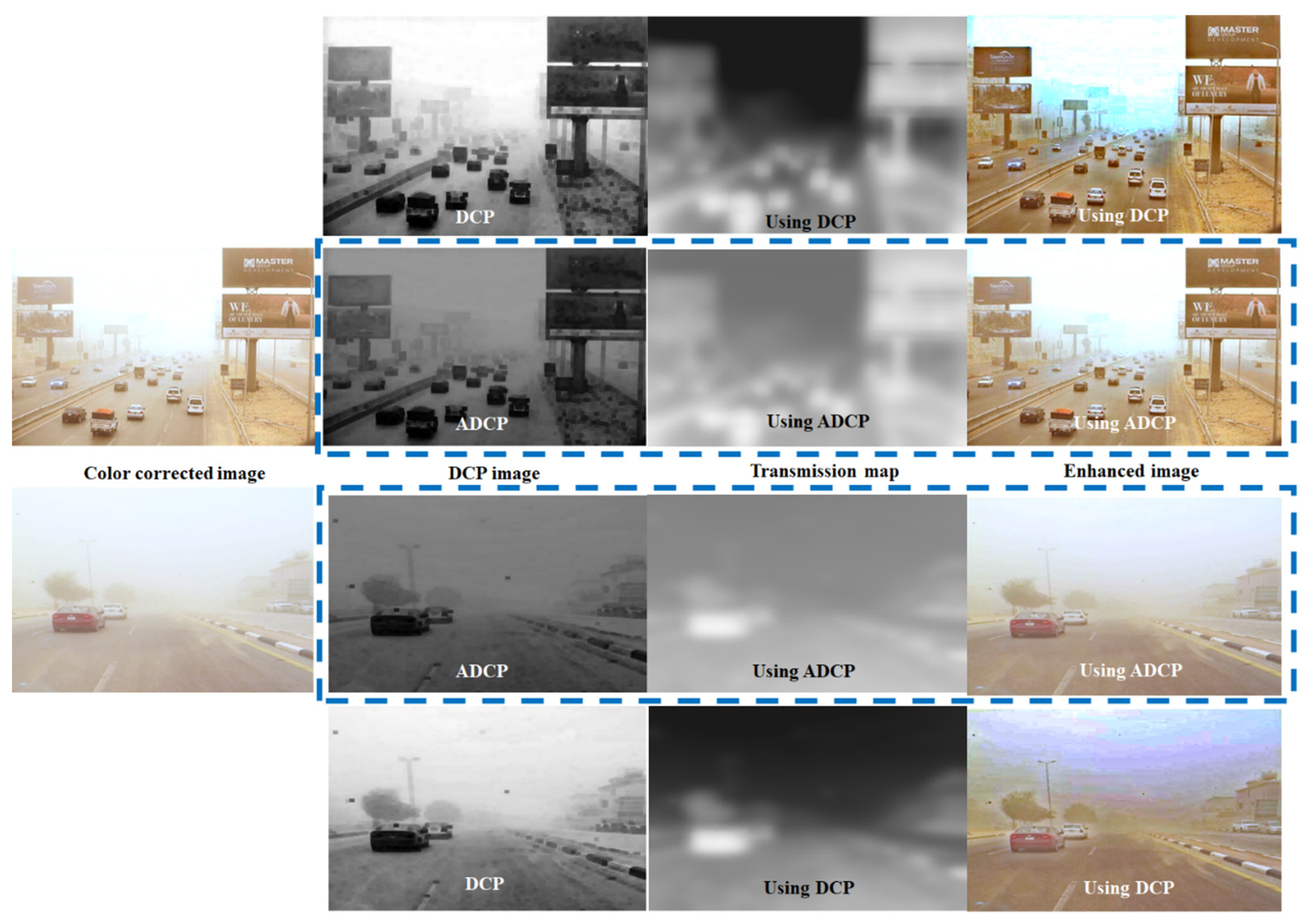
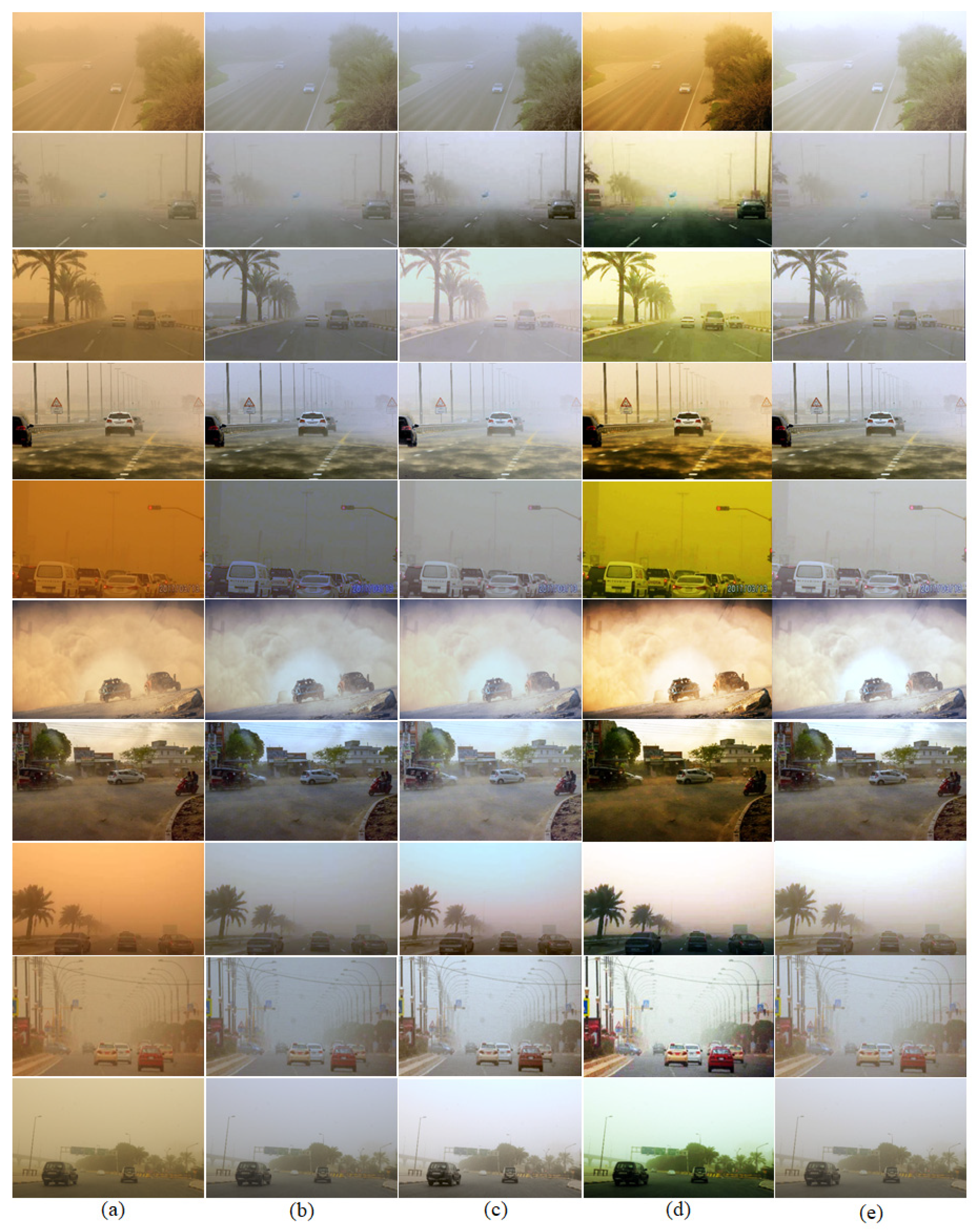
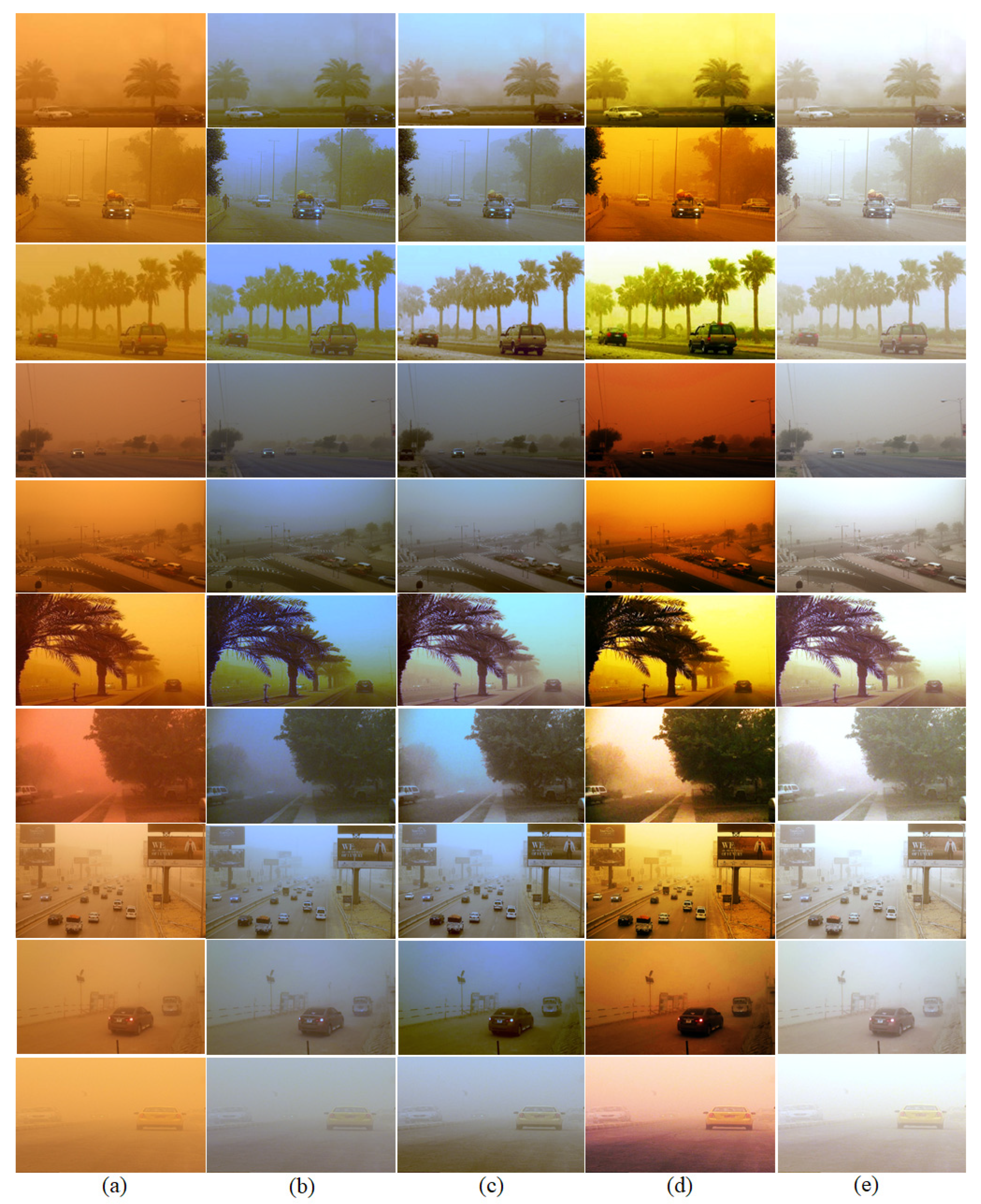
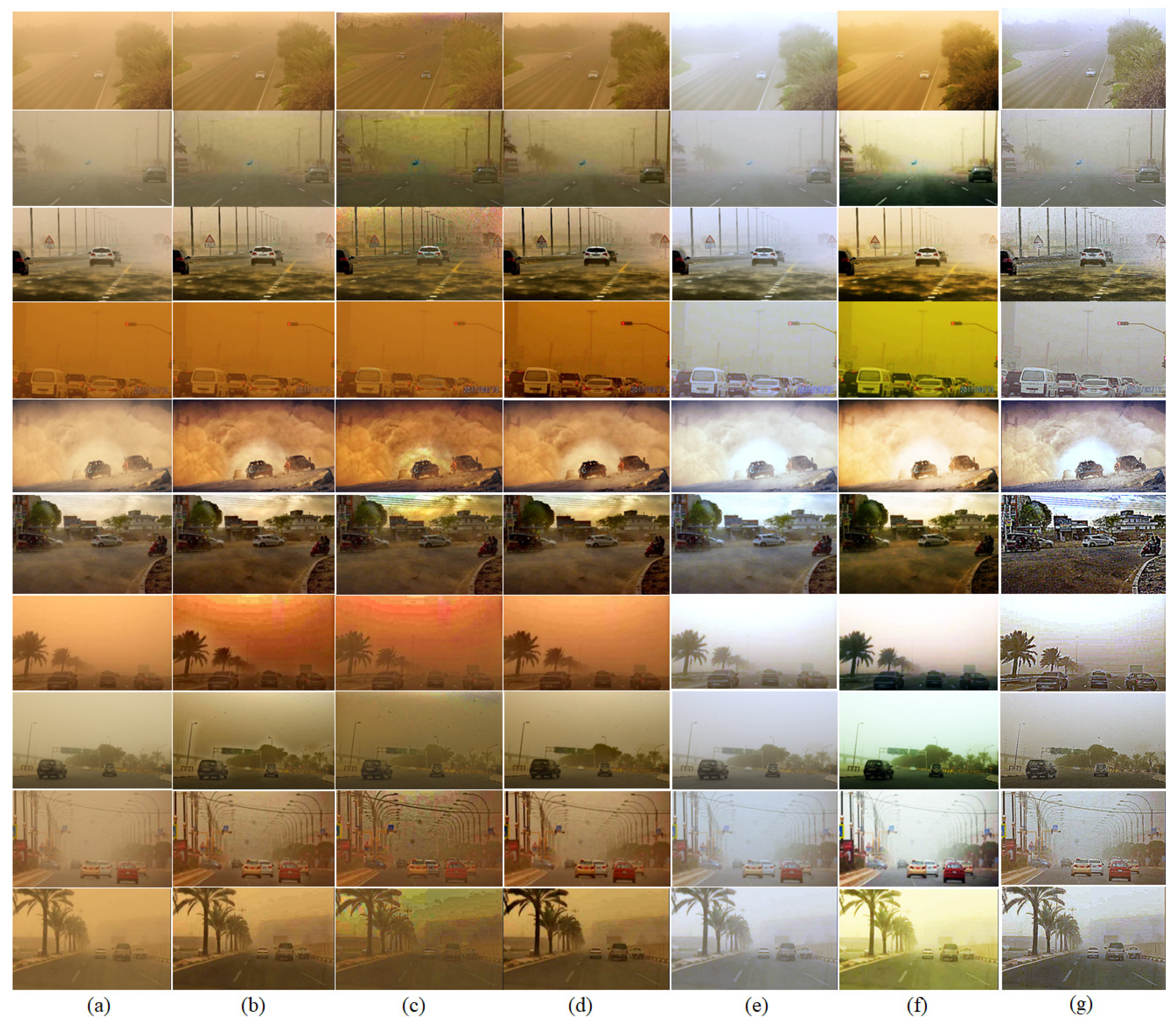
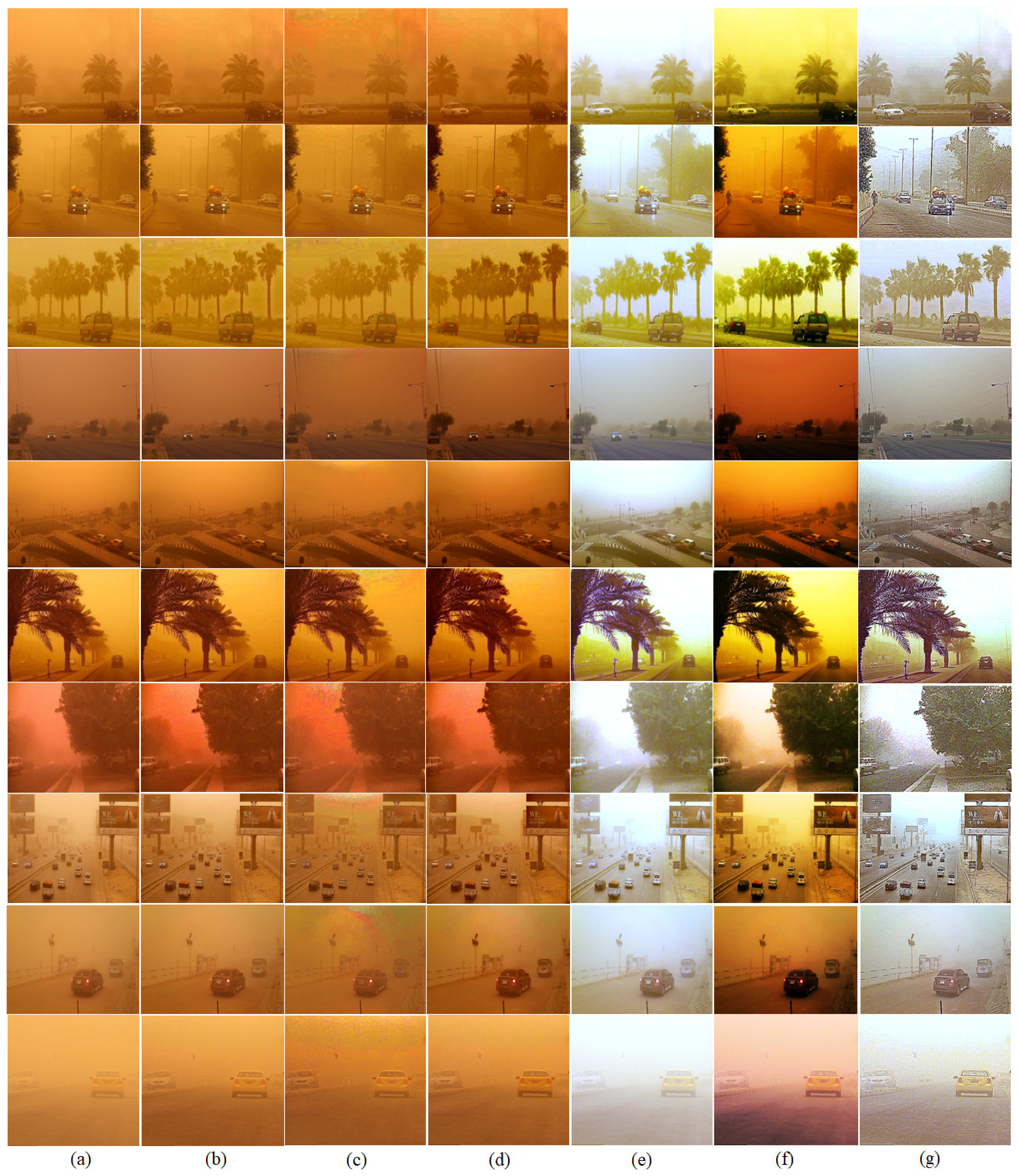
| Input | He et al. [1] | Meng et al. [2] | Ren et al. [15] | Gao et al. [7] | Al Ameen [4] | Proposed Method | |
|---|---|---|---|---|---|---|---|
| 19.346 | 19.252 | 19.186 | 19.202 | 19.200 | 18.947 | 15.496 | |
| 19.896 | 19.824 | 19.694 | 19.798 | 19.884 | 19.789 | 19.290 | |
| 19.304 | 19.036 | 17.475 | 18.940 | 19.220 | 19.141 | 14.670 | |
| 21.091 | 21.053 | 21.832 | 20.829 | 20.354 | 20.425 | 16.682 | |
| 19.755 | 19.532 | 19.314 | 19.628 | 19.691 | 19.396 | 14.026 | |
| 21.608 | 20.770 | 22.205 | 21.236 | 21.084 | 23.200 | 15.248 | |
| 20.841 | 21.287 | 21.475 | 21.118 | 20.939 | 20.639 | 18.374 | |
| 19.844 | 19.707 | 19.624 | 19.768 | 19.824 | 19.762 | 17.067 | |
| 19.483 | 18.933 | 18.081 | 18.889 | 19.371 | 18.970 | 16.119 | |
| 20.419 | 20.106 | 21.001 | 20.087 | 20.236 | 19.982 | 16.272 | |
| AVG | 20.159 | 19.950 | 19.989 | 19.950 | 19.980 | 20.025 | 16.324 |
| Input | He et al. [1] | Meng et al. [2] | Ren et al. [15] | Gao et al. [7] | Al Ameen [4] | Proposed Method | |
|---|---|---|---|---|---|---|---|
| 0.551 | 0.630 | 0.691 | 0.701 | 0.652 | 0.906 | 1.639 | |
| 0.298 | 0.389 | 0.527 | 0.518 | 0.326 | 0.798 | 0.940 | |
| 0.941 | 1.236 | 1.441 | 1.436 | 1.020 | 1.161 | 1.771 | |
| 0.517 | 0.552 | 0.605 | 0.871 | 0.695 | 0.828 | 1.391 | |
| 0.569 | 0.849 | 0.981 | 0.870 | 0.628 | 0.794 | 1.986 | |
| 1.330 | 1.518 | 1.496 | 1.524 | 1.363 | 1.583 | 1.702 | |
| 0.548 | 0.809 | 0.622 | 0.687 | 0.627 | 0.943 | 1.940 | |
| 0.519 | 0.839 | 0.767 | 0.777 | 0.563 | 0.902 | 1.887 | |
| 0.573 | 0.973 | 1.242 | 1.007 | 0.671 | 1.009 | 1.582 | |
| 0.572 | 0.773 | 0.710 | 0.930 | 0.655 | 0.773 | 1.548 | |
| AVG | 0.642 | 0.857 | 0.908 | 0.932 | 0.720 | 0.970 | 1.639 |
| Input | He et al. [1] | Meng et al. [2] | Ren et al. [15] | Gao et al. [7] | Al Ameen [4] | Proposed Method | |
|---|---|---|---|---|---|---|---|
| 0.896 | 0.860 | 0.805 | 0.828 | 0.950 | 0.832 | 0.726 | |
| 0.939 | 0.908 | 0.840 | 0.882 | 0.960 | 0.889 | 0.928 | |
| 0.847 | 0.782 | 0.698 | 0.686 | 0.885 | 0.771 | 0.478 | |
| 0.807 | 0.790 | 0.803 | 0.606 | 0.940 | 0.714 | 0.834 | |
| 0.915 | 0.844 | 0.832 | 0.856 | 0.958 | 0.904 | 0.758 | |
| 0.752 | 0.589 | 0.630 | 0.568 | 0.800 | 0.615 | 0.115 | |
| 0.878 | 0.714 | 0.809 | 0.818 | 0.948 | 0.909 | 0.718 | |
| 0.906 | 0.824 | 0.818 | 0.836 | 0.941 | 0.895 | 0.716 | |
| 0.897 | 0.802 | 0.761 | 0.771 | 0.943 | 0.920 | 0.696 | |
| 0.884 | 0.823 | 0.809 | 0.757 | 0.944 | 0.884 | 0.733 | |
| AVG | 0.872 | 0.794 | 0.781 | 0.761 | 0.927 | 0.833 | 0.670 |
| Input | He et al. [1] | Meng et al. [2] | Ren et al. [15] | Gao et al. [7] | Al Ameen [4] | Proposed Method | |
|---|---|---|---|---|---|---|---|
| 1.667 | 1.310 | 0.808 | 1.143 | 5.522 | 1.303 | 0.572 | |
| 3.042 | 2.154 | 1.215 | 1.824 | 8.682 | 2.780 | 1.793 | |
| 0.746 | 0.499 | 0.305 | 0.412 | 1.126 | 0.591 | 0.175 | |
| 1.019 | 0.965 | 0.999 | 0.809 | 3.146 | 0.891 | 1.041 | |
| 1.548 | 0.824 | 0.645 | 0.929 | 4.224 | 1.659 | 0.441 | |
| 0.408 | 0.259 | 0.255 | 0.258 | 0.627 | 0.283 | 0.128 | |
| 1.280 | 0.614 | 0.687 | 0.962 | 4.644 | 3.110 | 0.703 | |
| 2.048 | 1.035 | 0.763 | 1.252 | 4.888 | 2.573 | 0.468 | |
| 0.913 | 0.558 | 0.418 | 0.566 | 2.243 | 1.487 | 0.257 | |
| 1.528 | 1.092 | 0.913 | 1.027 | 4.533 | 1.712 | 0.775 | |
| AVG | 1.420 | 0.931 | 0.701 | 0.918 | 3.964 | 1.639 | 0.635 |
| Input | He et al. [1] | Meng et al. [2] | Ren et al. [15] | Gao et al. [7] | Al Ameen [4] | Proposed Method | |
|---|---|---|---|---|---|---|---|
| 19.969 | 19.930 | 19.997 | 19.940 | 20.064 | 19.825 | 18.941 | |
| 21.066 | 21.101 | 20.804 | 21.324 | 20.174 | 21.203 | 14.470 | |
| 20.157 | 20.202 | 20.102 | 20.130 | 19.901 | 19.515 | 17.705 | |
| 19.585 | 19.569 | 19.523 | 19.518 | 19.513 | 19.548 | 18.385 | |
| 19.898 | 19.863 | 19.699 | 19.724 | 19.811 | 19.772 | 15.903 | |
| 19.417 | 19.378 | 19.756 | 19.331 | 18.565 | 19.207 | 15.752 | |
| 20.658 | 20.881 | 21.030 | 20.666 | 20.398 | 20.553 | 16.175 | |
| 20.469 | 20.302 | 20.167 | 20.248 | 20.093 | 19.902 | 14.293 | |
| 20.265 | 20.243 | 20.250 | 20.212 | 20.183 | 20.118 | 18.194 | |
| 19.510 | 19.373 | 18.908 | 19.337 | 19.456 | 19.258 | 15.743 | |
| AVG | 20.099 | 20.084 | 20.024 | 20.043 | 19.816 | 19.890 | 16.556 |
| Input | He et al. [1] | Meng et al. [2] | Ren et al. [15] | Gao et al. [7] | Al Ameen [4] | Proposed Method | |
|---|---|---|---|---|---|---|---|
| 0.364 | 0.386 | 0.328 | 0.437 | 0.523 | 0.678 | 1.123 | |
| 0.907 | 0.919 | 0.932 | 1.123 | 1.126 | 1.264 | 1.851 | |
| 0.477 | 0.493 | 0.468 | 0.630 | 0.739 | 1.003 | 1.398 | |
| 0.381 | 0.434 | 0.506 | 0.620 | 0.474 | 0.753 | 1.406 | |
| 0.839 | 0.883 | 0.924 | 1.083 | 1.009 | 1.211 | 2.076 | |
| 0.890 | 0.910 | 0.939 | 1.067 | 1.060 | 1.182 | 1.625 | |
| 0.615 | 0.773 | 0.690 | 0.814 | 0.777 | 1.140 | 1.729 | |
| 0.797 | 0.888 | 0.910 | 0.951 | 0.927 | 1.205 | 1.911 | |
| 0.356 | 0.418 | 0.434 | 0.553 | 0.502 | 0.823 | 1.348 | |
| 0.377 | 0.611 | 0.869 | 0.659 | 0.496 | 0.736 | 1.535 | |
| AVG | 0.600 | 0.672 | 0.700 | 0.794 | 0.763 | 1.000 | 1.600 |
| Input | He et al. [1] | Meng et al. [2] | Ren et al. [15] | Gao et al. [7] | Al Ameen [4] | Proposed Method | |
|---|---|---|---|---|---|---|---|
| 0.795 | 0.750 | 0.762 | 0.612 | 0.889 | 0.709 | 0.897 | |
| 0.627 | 0.611 | 0.612 | 0.285 | 0.754 | 0.339 | 0.393 | |
| 0.657 | 0.516 | 0.629 | 0.332 | 0.760 | 0.573 | 0.816 | |
| 0.858 | 0.845 | 0.803 | 0.776 | 0.944 | 0.733 | 0.846 | |
| 0.664 | 0.648 | 0.625 | 0.438 | 0.783 | 0.448 | 0.412 | |
| 0.599 | 0.570 | 0.542 | 0.289 | 0.706 | 0.378 | 0.482 | |
| 0.783 | 0.659 | 0.746 | 0.553 | 0.892 | 0.714 | 0.478 | |
| 0.796 | 0.722 | 0.717 | 0.617 | 0.889 | 0.656 | 0.543 | |
| 0.862 | 0.842 | 0.804 | 0.773 | 0.950 | 0.776 | 0.860 | |
| 0.882 | 0.832 | 0.771 | 0.822 | 0.969 | 0.906 | 0.766 | |
| AVG | 0.752 | 0.700 | 0.701 | 0.550 | 0.854 | 0.623 | 0.649 |
| Input | He et al. [1] | Meng et al. [2] | Ren et al. [15] | Gao et al. [7] | Al Ameen [4] | Proposed Method | |
|---|---|---|---|---|---|---|---|
| 1.229 | 1.114 | 0.959 | 1.010 | 3.181 | 1.202 | 1.518 | |
| 0.507 | 0.489 | 0.446 | 0.405 | 1.100 | 0.396 | 0.262 | |
| 0.765 | 0.628 | 0.675 | 0.644 | 1.184 | 0.888 | 0.678 | |
| 1.046 | 0.961 | 0.774 | 0.770 | 3.896 | 0.758 | 0.572 | |
| 0.502 | 0.465 | 0.417 | 0.373 | 1.178 | 0.381 | 0.239 | |
| 0.601 | 0.554 | 0.502 | 0.507 | 0.947 | 0.539 | 0.351 | |
| 0.621 | 0.468 | 0.498 | 0.482 | 1.419 | 0.541 | 0.310 | |
| 0.714 | 0.573 | 0.463 | 0.533 | 1.588 | 0.511 | 0.290 | |
| 1.192 | 1.087 | 0.838 | 0.917 | 3.877 | 0.913 | 0.792 | |
| 0.884 | 0.661 | 0.492 | 0.621 | 5.226 | 1.406 | 0.560 | |
| AVG | 0.806 | 0.700 | 0.606 | 0.626 | 2.360 | 0.754 | 0.557 |
| Input | He et al. [1] | Meng et al. [2] | Ren et al. [15] | Gao et al. [7] | Al Ameen [4] | Proposed Method | |
|---|---|---|---|---|---|---|---|
| AVG (20) | 20.129 | 20.017 | 20.006 | 19.996 | 19.898 | 19.958 | 16.440 |
| AVG (373) | 20.032 | 19.863 | 19.698 | 19.892 | 19.931 | 19.803 | 16.988 |
| Input | He et al. [1] | Meng et al. [2] | Ren et al. [15] | Gao et al. [7] | Al Ameen [4] | Proposed Method | |
|---|---|---|---|---|---|---|---|
| AVG (20) | 0.621 | 0.764 | 0.804 | 0.863 | 0.742 | 0.985 | 1.619 |
| AVG (323) | 0.600 | 0.806 | 0.928 | 0.840 | 0.671 | 0.938 | 1.615 |
| Input | He et al. [1] | Meng et al. [2] | Ren et al. [15] | Gao et al. [7] | Al Ameen [4] | Proposed Method | |
|---|---|---|---|---|---|---|---|
| AVG (20) | 0.812 | 0.747 | 0.741 | 0.655 | 0.890 | 0.728 | 0.660 |
| AVG (323) | 0.851 | 0.780 | 0.756 | 0.746 | 0.888 | 0.781 | 0.724 |
| Input | He et al. [1] | Meng et al. [2] | Ren et al. [15] | Gao et al. [7] | Al Ameen [4] | Proposed Method | |
|---|---|---|---|---|---|---|---|
| AVG (20) | 1.113 | 0.815 | 0.654 | 0.772 | 3.161 | 1.196 | 0.596 |
| AVG (323) | 2.476 | 1.358 | 0.798 | 1.349 | 3.648 | 1.675 | 0.594 |
Publisher’s Note: MDPI stays neutral with regard to jurisdictional claims in published maps and institutional affiliations. |
© 2022 by the author. Licensee MDPI, Basel, Switzerland. This article is an open access article distributed under the terms and conditions of the Creative Commons Attribution (CC BY) license (https://creativecommons.org/licenses/by/4.0/).
Share and Cite
Lee, H.-S. Efficient Color Correction Using Normalized Singular Value for Duststorm Image Enhancement. J 2022, 5, 15-34. https://doi.org/10.3390/j5010002
Lee H-S. Efficient Color Correction Using Normalized Singular Value for Duststorm Image Enhancement. J. 2022; 5(1):15-34. https://doi.org/10.3390/j5010002
Chicago/Turabian StyleLee, Ho-Sang. 2022. "Efficient Color Correction Using Normalized Singular Value for Duststorm Image Enhancement" J 5, no. 1: 15-34. https://doi.org/10.3390/j5010002
APA StyleLee, H.-S. (2022). Efficient Color Correction Using Normalized Singular Value for Duststorm Image Enhancement. J, 5(1), 15-34. https://doi.org/10.3390/j5010002





